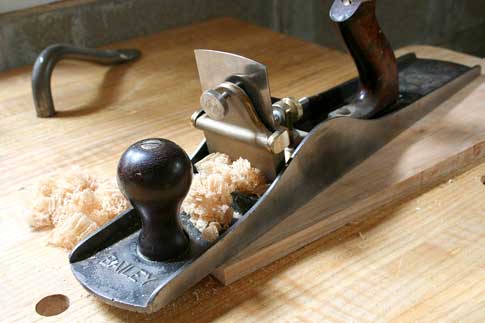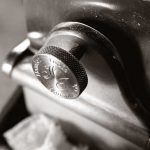We may receive a commission when you use our affiliate links. However, this does not impact our recommendations.

Long-time toolmaker Paul Hamler has developed a new device that can turn many handplanes (both vintage and new) into a scraping plane that is easier to set up, tune and use than any other scraping plane I’ve used.
I’ve been working with a pre-production version of this scraping insert , which simply replaces the frog on your plane , for about three weeks now. And already I’m convinced that I want one in my personal toolkit and I’ve placed an order with Hamler. This is despite the fact that neither the price (an estimated $125 to $150) nor the delivery date (some time later in 2007) is yet firm.
But I’m getting ahead of myself here. There are lots of questions that first must be answered about this unusual piece of equipment and why it might belong in your shop. Some readers might even wonder why anyone should spend money on a scraping plane when a card scraper can be had for $7 to do the same job. (The reason is that a card scraper is more likely to dish your surface, leaving ugly ripples that show up when you apply a film finish. Scraper planes don’t do that.)
In fact, one of the first questions is why bother with this scraping insert when there’s another one available from Lee Valley Tools. Good question. The interesting answer is that the Veritas Scraping Plane Insert was invented by Hamler (he, Leonard Lee and John S. Lynn are listed as the inventors on the 1996 patent papers). Hamler says he thought the design and materials of the original could be improved upon and so he developed this new insert and is producing and selling it himself.
And indeed, this new insert is almost nothing like the Veritas version. Here’s how it works:
The insert fits into the wide-bodied Bailey-pattern and Bed Rock-pattern planes made by Stanley , the Nos. 4-1/2, 5-1/2, 6 and 7. The Bed Rock version also will fit Lie-Nielsen wide-bodied planes of the same sizes.
To install the insert you remove the entire frog assembly of your plane and replace it with Hamler’s device. Tighten the plane’s frog mounting screws and the job is done. The scraper, a thin 2-1/2″-wide piece of steel, drops into the tool and is secured with a single thumbscrew. This looks and feels just like Stanley’s old scraper planes, such as the Nos. 12, 112 and 212. But this is where the similarity to the old (and existing new) tools ends.
Intuitive Controls
The way you adjust Hamler’s scraping insert is truly ingenious and improves upon more than 100 years of doing things the hard way. What’s the hard way? If you own a scraping plane, you already know the answer. You adjust the cut of a traditional scraping plane by pitching the scraper backward and forward. Tipping the scraper forward makes the cut deeper and more aggressive. Tipping it back has the opposite effect.
One of the most frustrating things about the old mechanism is that it’s a true pain to change the angle. You change it by loosening two jam nuts. Then you twist one to tip the tooling forward or twist the other tip it back. Then you have to retighten the two jam nuts and test your cut. If you don’t get it the first time (and you won’t) then it’s back to the jam nuts for another round of righty-tighty time.
Hamler’s insert replaced the forward jam nut with a strong spring. So to adjust the scraper forward you turn the knob counter-clockwise and take a cut. To move the scraper back you turn the knob clockwise and take a cut. No jam nuts. No overshooting your mark. It works and feels much more like using a bench plane than the torture device that is the No. 112’s mechanism.
So how does Hamler get away with removing that forward jam nut? Isn’t it necessary to keep the insert rigid during the cut? Nope. The forward jam nut is a gill slit or an appendix. You need only one nut to keep the insert rigid because rigidity is important only when the tool is cutting , and that’s what the rear knob does. The spring keeps all the parts in tension so things aren’t flopping around annoyingly on the return stroke.
But About That Length…¦
The other curious aspect of the insert is that Hamler made it for (and demonstrates it in) a jointer plane body. That’s a 22″-long plane. Traditional scraper planes are much more like smoothing planes (the No. 112 is about 9″ long). Why do you need a scraper insert in a jointer plane?
I haven’t talked to Hamler about this specifically, so he might have another opinion on it. But here are my thoughts. Scraper planes excel at dealing with large surfaces that have a lot of grain problems. I use them especially when dealing with glued-up tabletops. When you glue up a top, the first order of business is to arrange the boards to best appearance. But that might involve a lot of boards that have grain running in opposite directions.
Hand planing a top like this is a massive pain. And getting the seams right is enough to drive one to the random-orbit sander. But a scraper plane can generally ignore grain reversals. So you can flatten the top with a jointer plane and then follow up with a jointer-sized scraper with no problem. In other words, just skip the smoothing plane when the deck is stacked against you and go right to the scraper plane.
This is a time-saver in unexpected ways. Typically, I’d try to deal with a top first with a jointer plane, then a high-angle smooth plane, then a card scraper to deal with localized tear-out, then sandpaper to blend the planed and scraped surfaces together. With the Hamler insert I can go from jointer plane to jointer scraper to a bit of hand sanding.
If you like the shorter format, you can always put the insert in a No. 4-1/2 and it will be much like a No. 112. But I like the extra mass of the No. 6 that I have the prototype in. Plus, the longer plane will result in a flatter surface than a shorter plane or the washboarding that comes with a card scraper in inexperienced hands.
Another objection that some woodworkers might make is that you can convert a bench plane, HNT Gordon plane or bevel-up plane to a scraping plane using various tricks (such as large back bevels, turning the iron over or honing a very steep secondary bevel). All of these work; I’ve tried them. But they don’t allow you to change the pitch of the tool forward and back, and that’s useful when dealing with different species and different hooks on the scraper. The Hamler insert handles this task with enormous ease. Plus, the Hamler insert can hold scrapers of different thicknesses so you can choose a thick one for aggressive work or a thin one for light cuts in tricky burls.
The pre-production model shown in these photos is utilitarian-looking, according to Hamler. The production version will have more spit and polish. Believe that. If you’ve ever seen any of Hamler’s other work (he specializes in miniature tools), it’s impressive.
Hamler doesn’t have a web site, but you can contact him via e-mail at hamlertools@alltel.net to inquire about getting your name on the list for one of these tools.

Here are some supplies and tools we find essential in our everyday work around the shop. We may receive a commission from sales referred by our links; however, we have carefully selected these products for their usefulness and quality.








